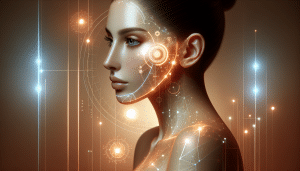You Can Transform Skin with Red Light Therapy
Natalie Brooks September 20, 2025
Wondering how red light therapy is reshaping skincare? This investigative guide explores the mechanisms, proven benefits, safety insights, and at-home options of red light therapy for various skin types. Explore expert-backed research and real considerations before embracing this wellness and beauty trend.
Understanding Red Light Therapy in Modern Skincare
Red light therapy has become a standout trend in skincare, seen everywhere from luxury spas to home devices. By emitting low-level wavelengths of red and near-infrared light, red light therapy is thought to support natural cellular recovery and rejuvenation. Many wellness experts refer to this modern technology as low-level laser (light) therapy—a method now used for both cosmetic and clinical skin goals. Curiosity around its role has grown as users share experiences about reduced redness, improved texture, and a perception of radiance after regular sessions (see NIH resource).
Clinics and dermatologists have tapped into red light therapy for concerns such as fine lines, mild inflammation, and unbalanced tone. Operating alongside traditional skincare, it offers a light-based angle that is non-invasive and painless. Various studies have explored how this therapy might boost collagen production and enhance overall skin appearance, drawing interest from both professionals and at-home enthusiasts. As a bonus, the sessions require minimal downtime and are often paired with other beauty services.
Interest in red light therapy is also driven by its technological development—today’s devices are more accessible, user-friendly, and designed for consistent, comfortable use. Whether embedded in facial panels or flexible masks, red light treatment at home continues to gain momentum due to this innovation. People are eager to discover whether consistent use will offer a noticeable difference, especially when compared with older, more aggressive procedures. But does science support the claims? Let’s look deeper.
The Science Behind Red Light Therapy and Skin Health
The cornerstone of red light therapy’s potential lies in how specific wavelengths interact with skin cells. Studies show that light in the red and near-infrared spectrum can reach deeper layers of the skin than ordinary light (source: NIH resource). Upon reaching the mitochondria, these wavelengths may stimulate cellular energy production, enhancing cell repair and turnover. This process, referred to as photobiomodulation, underpins claims that red light therapy could support better skin tone, firmness, and surface texture.
Collagen is a key player in youthful-looking skin. Evidence from clinical reviews shows that red light exposure may lead to mild increases in collagen density, improving firmness and reducing the appearance of wrinkles over time (source: American Academy of Dermatology). Although individual results vary and improvements develop gradually, advances in photomedicine suggest that these gains can be meaningful for some skin types and conditions.
Beyond appearance, red light therapy has also been examined in relation to wound healing and inflammatory conditions. Some early studies indicate potential for helping with chronic sun damage, acne-related redness, and even the itching associated with some forms of eczema when used consistently and under expert guidance. It’s important, however, to distinguish between cosmetic improvements and the treatment of medical skin conditions—consulting with a dermatologist or healthcare provider remains essential where health is at stake (source: Harvard Health).
Safety Insights and Considerations for Home Use
Safety is top of mind for most people when considering any new skincare approach, and red light therapy is no exception. Regulatory bodies such as the U.S. Food & Drug Administration (FDA) have cleared certain at-home red light devices, primarily for mild skin concerns and pain management. These approvals are typically based on robust clinical testing and safety data. That said, device standards can differ substantially, so choosing ones with strong safety credentials and clear usage guidelines is always recommended (FDA resource).
Proper use is crucial. Each device comes with recommended exposure times and distance from the skin to avoid overexposure. Most quality devices emit non-UV light, minimizing risks of burns or skin irritation. Sensitivity or mild discomfort can occur, but these effects are rare and often resolve quickly. Those with sensitive skin, active infections, or pre-existing dermatological concerns should especially seek medical supervision before beginning regular sessions.
Another consideration is the setting—dedicated time and suitable space help maintain consistent routines, which is important for seeing gradual results. As with any modality, red light therapy complements—rather than replaces—core skincare steps like cleansing, sun protection, and hydration. Combining approaches sensibly and following safety advice create a balanced, sustainable beauty plan.
Comparing In-Clinic and At-Home Red Light Experiences
The range of red light therapy devices spans from high-powered clinic-grade panels to compact home-use masks and wands. Professionals emphasize that in-clinic procedures are closely monitored, offering precise control over dosage and coverage, which can be reassuring for those with specific skin concerns (see ASDS overview). Additionally, practitioners can adjust complementary treatments for optimal energy and safety.
Home-use options offer convenience and affordability, with many reliable brands bringing the core benefits of red light therapy to people’s daily routines. These devices tend to have lower intensity and are intended for regular, gentle use over time. While results may require weeks or months to appear, users often prefer the ease of fitting treatments into their home routines and controlling the process themselves.
Some people alternate between clinic and home treatments, blending expert oversight with hands-on care. It’s also common for people to start with in-office sessions to learn what to expect and then maintain results at home. Carefully read device guides, maintain equipment hygiene, and adjust use based on personal comfort and progress for a balanced approach to red light therapy.
What to Realistically Expect from Red Light Therapy for Skin
Red light therapy can bring visible shifts, but understanding its limitations is key. Short-term outcomes might include subtle improvement in skin radiance and a reduction in minor redness, while longer-term, gradual shifts may include a softening of fine lines and smoother skin appearance. Sophisticated users note that the most obvious changes often build progressively after a phase of regular use rather than overnight. Patience is essential in seeing the rewards of skin cell renewal and collagen support.
This isn’t a “fix-all” solution. Results often depend on individual skin characteristics, the specific device chosen, and adherence to use guidelines. Well-controlled clinical reviews outline that benefits are supported by ongoing use and are maximized when paired with a healthy, gentle skincare regimen and lifestyle. Skipping sessions or neglecting sun protection may reduce the gains, so consistency really does matter.
Common myths do circulate, often exaggerating how quickly or dramatically results appear. Instead, trusted dermatological resources encourage people to assess progress realistically and maintain expectations based on the available science. By staying curious, well-informed, and patient, anyone interested in red light therapy can make empowered decisions that reflect their unique goals for healthy, luminous skin.
Red Light Therapy in a Holistic Beauty and Wellness Routine
Red light therapy is best viewed as one tool among many in a comprehensive self-care regimen. For many, it sits alongside balanced nutrition, hydration, gentle skincare, and sun protection. Mindful habits—such as stress management and good sleep—further enhance the benefits achieved from consistent light exposure. Seasoned users often treat their red light sessions as a ritual, building them into a broader plan for beauty and well-being.
Emerging research hints at other possible advantages, such as mood support, temporary muscular pain relief, and relaxation, although further high-quality studies are needed here (see Psychology Today). When used thoughtfully, light therapy can gently encourage improved feelings of balance and resilience, inside and out. This adds a modern twist to the age-old pursuit of skin radiance and overall wellness.
While trends will continue to emerge, red light therapy merits consideration for those looking to experiment with evidence-backed techniques. Consulting a professional, setting reasonable goals, and enjoying the gradual progress are cornerstones of a rewarding experience. Whether at a clinic or in one’s own living room, curiosity and careful research ensure red light therapy plays a productive role in a personal wellness journey—one step among many on the route to healthy, beautiful skin.
References
1. Avci, P., Gupta, A., Sadasivam, M., Vecchio, D., Pam, Z., Pam, N., & Hamblin, M. R. (2013). Low-level laser (light) therapy (LLLT) in skin: stimulating, healing, restoring. Retrieved from https://www.ncbi.nlm.nih.gov/pmc/articles/PMC3926176/
2. American Academy of Dermatology Association. Red light therapy: Can it help with skin conditions? Retrieved from https://www.aad.org/public/diseases/a-z/red-light-therapy
3. Harvard Health Publishing. Red light therapy: What you need to know. Retrieved from https://www.health.harvard.edu/blog/red-light-therapy-what-you-need-to-know-2020122221582
4. U.S. Food & Drug Administration. Light-Based Home Devices for Skin. Retrieved from https://www.fda.gov/consumers/consumer-updates/light-based-home-devices-skin
5. American Society for Dermatologic Surgery. Red light therapy. Retrieved from https://www.asds.net/skin-experts/skin-treatments/red-light-therapy
6. Psychology Today. Can Red Light Therapy Brighten Your Mood? Retrieved from https://www.psychologytoday.com/us/blog/urban-survival/202104/can-red-light-therapy-brighten-your-mood








